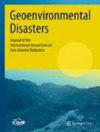利用正向无标记机器学习方法加强滑坡易发性绘图:印度查莫利的案例研究
IF 4
Q2 ENVIRONMENTAL SCIENCES
引用次数: 0
摘要
印度喜马拉雅山易发生山体滑坡,特别是作为气候变化影响可能成为事件催化剂的地区,有必要开发可靠的山体滑坡易发性地图(LSM)。本研究有别于传统的二元分类模型,将 LSM 定义为一个正向无标记学习问题。这种方法承认,没有山体滑坡记录的地区并不一定是低风险地区,而可能只是尚未经历过山体滑坡。该研究利用新颖的正向无标记学习增强算法--随机森林、K-近邻和决策树--为印度 Chamoli 地区创建了 LSM。确定了山体滑坡的 11 个致因因素,包括海拔、坡向、坡度、地质、地貌、与线状物的距离、岩性、NDVI、与河流的距离、与道路的距离和住宅用地。为解决空间相关性偏差问题,该研究采用空间分割法来获得训练数据集和测试数据集,而不是随机分割数据集。研究发现,正向无标记学习大大提高了曲线下面积和召回率,与二元分类方法相比,LSM 更为保守。分析表明,查莫利南部地区的召回率较高,但准确率较低,这表明尽管该地区历史上没有发生过山体滑坡,但潜在的山体滑坡易发性较高。该研究还量化了人类活动对滑坡风险的影响,表明滑坡对生命和当地经济的威胁增大,尤其是在查莫利的西南部地区。本文章由计算机程序翻译,如有差异,请以英文原文为准。
Enhancing landslide susceptibility mapping using a positive-unlabeled machine learning approach: a case study in Chamoli, India
The Indian Himalayas' susceptibility to landslides, particularly as a location where climate change effects may be event catalysts, necessitates the development of dependable landslide susceptibility maps (LSM). This study diverges from traditional binary classification models, framing LSM as a positive-unlabeled learning problem. This approach acknowledges that regions without recorded landslides are not necessarily at low risk but could simply have not experienced landslides yet. The study utilizes novel positive-unlabeled learning-enhanced algorithms—Random Forest, K-Nearest Neighbor, and Decision Tree—to create LSM for Chamoli district, India. Eleven causative factors for landslides are identified, including elevation, aspect, slope, geology, geomorphology, distance to lineament, lithology, NDVI, distance to river, distance to road and residential land use. To address spatial correlation biases, instead of randomly splitting the dataset, the study adopts spatial splitting to get the training and testing datasets. The study reveals that positive-unlabeled learning substantially improves the Area Under Curve and recall, leading to a more conservative LSM compared to binary classification methods. Analysis shows that the southern region of Chamoli exhibits high recall but lower accuracy, suggesting a latent high landslide susceptibility despite a lack of historical landslides in this region. The study also quantifies the impact of human activity on landslide risk, indicating an elevated threat to life and the local economy, especially in Chamoli's southwestern areas.
求助全文
通过发布文献求助,成功后即可免费获取论文全文。
去求助
来源期刊

Geoenvironmental Disasters
Social Sciences-Geography, Planning and Development
CiteScore
8.90
自引率
6.20%
发文量
22
期刊介绍:
Geoenvironmental Disasters is an international journal with a focus on multi-disciplinary applied and fundamental research and the effects and impacts on infrastructure, society and the environment of geoenvironmental disasters triggered by various types of geo-hazards (e.g. earthquakes, volcanic activity, landslides, tsunamis, intensive erosion and hydro-meteorological events).
The integrated study of Geoenvironmental Disasters is an emerging and composite field of research interfacing with areas traditionally within civil engineering, earth sciences, atmospheric sciences and the life sciences. It centers on the interactions within and between the Earth''s ground, air and water environments, all of which are affected by climate, geological, morphological and anthropological processes; and biological and ecological cycles. Disasters are dynamic forces which can change the Earth pervasively, rapidly, or abruptly, and which can generate lasting effects on the natural and built environments.
The journal publishes research papers, case studies and quick reports of recent geoenvironmental disasters, review papers and technical reports of various geoenvironmental disaster-related case studies. The focus on case studies and quick reports of recent geoenvironmental disasters helps to advance the practical understanding of geoenvironmental disasters and to inform future research priorities; they are a major component of the journal. The journal aims for the rapid publication of research papers at a high scientific level. The journal welcomes proposals for special issues reflecting the trends in geoenvironmental disaster reduction and monothematic issues. Researchers and practitioners are encouraged to submit original, unpublished contributions.
 求助内容:
求助内容: 应助结果提醒方式:
应助结果提醒方式:


